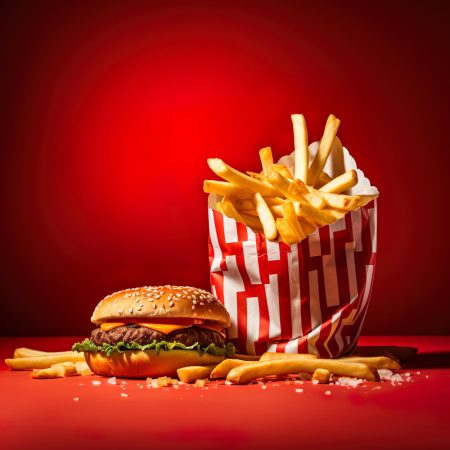1. Introduction
1.1 Why Diet Matters More Than Ever After 50
As we age, our body’s nutritional needs change, making it essential to rethink our dietary habits. After 50, the body’s metabolism naturally slows down, muscle mass begins to decrease, and certain health risks—like heart disease, diabetes, and osteoporosis—can become more prevalent. This is a stage of life when being intentional about food choices can have a profound impact on overall health, energy levels, and even longevity. Foods that may have been manageable or even beneficial earlier in life can now accelerate aging and negatively affect health.
Choosing the right foods is vital to support physical and cognitive health, boost immunity, and maintain an active, vibrant lifestyle. Just as there are foods that promote health and vitality, there are also foods to avoid after 50 to reduce the risk of chronic disease and age-related decline. Our dietary choices can either fuel us with nutrients or deplete us with essential resources that keep us feeling and looking our best.
1.2 How Food Choices Affect Aging
The foods we eat influence the body on a cellular level. Certain foods can contribute to inflammation, damage collagen (the protein that maintains skin elasticity), and disrupt hormone balance—all of which accelerate the visible and invisible signs of aging. Inflammation, for example, is linked to foods high in refined sugars and processed carbohydrates and can worsen conditions such as arthritis and heart disease. Excessive sodium intake is another factor that can lead to elevated blood pressure and dehydration, which impacts skin health and joint flexibility. In contrast, a diet focused on nutrient-dense options can improve overall well-being, enhance brain health, and reduce the physical signs of aging.
1.3 Purpose of Identifying Foods to Avoid After 50
The purpose of this guide on foods to avoid after 50 is to provide a practical and informed approach to diet that takes into consideration the changing needs of the body. By understanding the impact of specific foods, men and women over 50 can make conscious decisions that support optimal health and slow down the aging process. Avoiding foods that increase inflammation, stress blood sugar levels, or lack essential nutrients can greatly improve energy, vitality, and physical resilience.
Recognizing foods to avoid after 50 isn’t about strict restrictions or “dieting.” Rather, it’s a proactive approach to well-being, empowering individuals to make choices that enhance quality of life. This guide offers insights into the foods that are best limited or avoided to help readers maintain a youthful outlook, healthy body, and sustained energy as they age gracefully.
Affiliate Disclaimer
This blog post may include links to affiliate sites. If you click on an affiliate link and make a purchase, we may earn a small commission or receive other compensation at no extra cost to you. Please note that many of the links on our site are affiliate links. Our use of these links does not impact the products, services, or websites we recommend to you. This disclaimer covers all forms of communication with you, including our website, email, phone, social media, products, and other platforms.
Amazon Affiliate Disclaimer
We participate in the Amazon Services LLC Associates Program, an affiliate marketing program that allows us to earn fees by linking to Amazon.com and its affiliated sites. If you click on an Amazon affiliate link on our site and make a purchase, we may receive a small commission at no additional cost to you.
2. Understanding How Food Impacts Aging
2.1 The Connection Between Diet and Cellular Aging
As we grow older, our bodies naturally experience cellular changes that affect how we look and feel. What many people don’t realize is that diet has a profound impact on the rate of cellular aging. Some foods, especially those high in refined sugars, unhealthy fats, and processed ingredients, can accelerate oxidative stress in the body. Oxidative stress occurs when there is an imbalance between free radicals (unstable molecules that can damage cells) and antioxidants, which protect our cells from damage. The foods we consume can either increase these harmful free radicals or support the body in defending against them. Therefore, understanding foods to avoid after 50 is crucial for reducing oxidative stress and supporting cellular health.
Choosing a diet that emphasizes whole foods over highly processed ones can greatly impact skin elasticity, energy levels, and the body’s overall ability to repair itself. This means limiting foods that contribute to inflammation and free radical production, as they can speed up the physical signs of aging, from wrinkles to joint stiffness. A thoughtful diet can serve as one of our best defenses against age-related decline, helping us maintain health and vitality longer.
2.2 Key Health Concerns After 50
Aging brings certain health risks that diet can influence directly, such as heart health, bone density, digestive function, and metabolism. These are areas of concern for many people over 50, and specific food choices can either improve or worsen these conditions. For instance, high-sodium foods can raise blood pressure, refined sugars can spike blood glucose levels, and excessive saturated fats can lead to higher cholesterol levels—all of which contribute to cardiovascular issues.
Bone health also becomes a priority after 50. The body’s ability to absorb calcium decreases with age, making it essential to avoid foods that may interfere with bone health, such as high-salt snacks or foods with excessive caffeine. By identifying foods to avoid after 50, individuals can make diet choices that protect bone density and reduce the risk of fractures or osteoporosis, which becomes more common in later years.

2.3 Foods to Avoid After 50 to Support Longevity
After age 50, maintaining a healthy metabolism can become more challenging due to natural declines in muscle mass and metabolic rate. Certain foods, such as refined carbs and sugary snacks, can further slow down metabolism and lead to weight gain, which in turn impacts joint health and mobility. High-sugar diets are also linked to insulin resistance, making it essential to monitor and reduce added sugars to prevent or manage conditions like Type 2 diabetes.
Inflammation is another factor that is heavily influenced by diet. Processed and fried foods are known to increase inflammation in the body, which can worsen joint pain, accelerate the aging process, and even impact mental health. By selecting foods to avoid after 50 that are known to trigger inflammation, individuals can protect their health, alleviate discomfort, and support their body’s ability to age gracefully.
Understanding how specific foods influence these age-related health risks allows individuals over 50 to make informed dietary choices. Focusing on a diet rich in antioxidants, vitamins, and minerals can reduce cellular aging, support vital health concerns, and promote longevity. This foundational knowledge sets the stage for adopting healthier eating habits and avoiding foods that could otherwise undermine one’s health and wellness in the years ahead.
3. Foods to Avoid After 50
Aging gracefully is as much about what we avoid as what we include in our diets. For those over 50, understanding which foods to limit or eliminate can make a significant difference in health, energy, and longevity. This section dives into key categories of foods to avoid after 50 to help reduce the risk of chronic conditions, support skin and bone health, and maintain vitality.
3.1 Processed Sugars and Sweets
Refined sugars and sweets are among the top foods to avoid after 50. Sugar can cause rapid spikes in blood sugar, leading to a quick burst of energy followed by a crash. This pattern, when repeated over time, can contribute to insulin resistance, which may eventually lead to Type 2 diabetes. Sugar also promotes inflammation, which has a negative impact on skin health, joint function, and immune response.
Beyond blood sugar concerns, high sugar intake can lead to glycation, a process where sugar molecules bind to proteins and lipids in the skin, causing stiffness and loss of elasticity. This results in wrinkles and a more aged appearance. Limiting processed sugars and opting for natural sweeteners like honey or maple syrup (in moderation) can help control these risks while satisfying a sweet craving.
3.2 Refined Carbohydrates
Refined carbohydrates, such as white bread, pastries, and sugary cereals, are foods to avoid after 50 due to their minimal nutritional value and high glycemic index. Like processed sugars, refined carbs quickly raise blood sugar levels, which can lead to insulin resistance and weight gain. Over time, excess weight can strain the joints and increase the risk of conditions like osteoarthritis.
Refined carbs also lack fiber, a key component that aids digestion and promotes healthy gut bacteria. For older adults, maintaining gut health is essential, as it supports immunity and overall wellness. Replacing refined carbohydrates with whole grains like quinoa, oats, and brown rice is a better choice, offering fiber, vitamins, and minerals that help stabilize blood sugar and promote digestive health.

3.3 High-Sodium Foods
Salt is necessary for bodily functions, but excessive sodium intake can become problematic, especially after 50. High-sodium foods, such as processed meats, canned soups, and packaged snacks, can raise blood pressure, increasing the risk of heart disease and stroke. Excess sodium also affects kidney function and can lead to fluid retention, which may cause bloating and discomfort.
For those concerned with bone health, sodium poses additional risks. High-sodium diets are linked to calcium loss in bones, which can increase the risk of osteoporosis over time. Reducing sodium intake by choosing fresh, whole foods and flavoring meals with herbs and spices instead of salt can help keep blood pressure in check and protect bone density.
3.4 Fried and Fast Foods
Fried and fast foods are widely recognized as foods to avoid after 50 due to their high levels of unhealthy fats, particularly trans fats and saturated fats. Trans fats, found in many fried and processed foods, raise bad cholesterol (LDL) levels while lowering good cholesterol (HDL), increasing the risk of heart disease. Saturated fats, although less harmful than trans fats, should also be limited, as they can contribute to weight gain and inflammation.
Inflammation is a common issue as we age and can exacerbate conditions like arthritis and cardiovascular disease. Fried foods are also difficult to digest and can lead to bloating or discomfort, particularly for older adults whose digestive systems may not process fats as efficiently. Choosing baked or grilled options instead of fried, along with incorporating healthy fats from sources like olive oil, avocado, and nuts, can help reduce inflammation and protect cardiovascular health.
3.5 Alcohol and Sugary Beverages
Alcohol and sugary drinks, such as sodas and energy drinks, are other categories to be cautious with after 50. Alcohol can affect liver function, hydration, and sleep quality—all critical for aging well. Excessive alcohol intake is also associated with an increased risk of hypertension, liver disease, and certain cancers. Sugary beverages add extra calories without nutritional benefit, contributing to weight gain and increased risk of insulin resistance.

Additionally, alcohol and sugary drinks can lead to dehydration, which affects skin elasticity and makes fine lines more visible. Hydration is essential for maintaining a youthful appearance, so limiting these beverages and replacing them with water, herbal teas, or sparkling water with a splash of citrus can be a healthier choice.
3.6 Red and Processed Meats
Red and processed meats, including bacon, sausages, and deli meats, are foods to avoid after 50 for multiple reasons. Processed meats contain preservatives and high levels of sodium, which can increase the risk of hypertension and cardiovascular disease. Furthermore, studies have linked regular consumption of red and processed meats to an increased risk of colorectal cancer.
These meats can also be high in saturated fats, which contribute to cholesterol buildup and inflammation. Opting for leaner protein sources such as chicken, turkey, fish, and plant-based proteins can help meet protein needs without increasing the risks associated with red and processed meats.
3.7 Artificial Sweeteners
While artificial sweeteners may seem like a healthy alternative to sugar, they can disrupt gut health and even lead to increased sugar cravings. Artificial sweeteners can alter the balance of gut bacteria, which plays a crucial role in digestion, immunity, and mental health. Some studies also suggest that artificial sweeteners may lead to weight gain by tricking the brain into craving more sugary foods.
Natural sweeteners like stevia or fruit can offer a safer way to satisfy sweet cravings. By limiting artificial sweeteners, individuals can support gut health and reduce sugar cravings, helping to maintain a balanced diet over time.
3.8 Summary of Foods to Avoid After 50
Avoiding certain foods after 50 is not about strict dieting but making informed choices that support overall health and well-being. By limiting processed sugars, refined carbs, high-sodium foods, fried and fast foods, sugary drinks, red and processed meats, and artificial sweeteners, individuals over 50 can help protect their cardiovascular, digestive, and skeletal health while maintaining energy and vitality as they age.
4. The Benefits of Avoiding These Foods
4.1 Enhanced Energy and Mental Clarity
As we age, maintaining consistent energy levels and mental clarity becomes increasingly important. By focusing on foods to avoid after 50—such as refined sugars, processed foods, and high-sodium snacks—individuals can prevent the energy crashes and mental fog that often come from blood sugar spikes and poor nutrition. Eliminating refined sugars and unhealthy fats, for instance, helps stabilize blood glucose levels, preventing energy dips and supporting steady focus throughout the day. A balanced diet with whole foods also provides sustained energy, giving people over 50 the vitality they need to stay active and mentally sharp.
4.2 Improved Heart Health
Heart health is a major concern for people over 50, as the risk of cardiovascular diseases tends to increase with age. Choosing foods wisely can make a significant difference. Many foods to avoid after 50, such as fried foods, processed meats, and high-sodium items, contribute to increased blood pressure, high cholesterol, and inflammation—all of which strain the heart. Processed foods, for example, are often laden with trans fats and hidden sodium, both of which are detrimental to cardiovascular health. By avoiding these foods and replacing them with heart-healthy options like fruits, vegetables, and lean proteins, individuals can reduce their risk of heart disease, stroke, and other cardiovascular issues.
4.3 Better Joint Health and Reduced Inflammation
Inflammation is a natural response of the body but can become chronic with age, particularly when triggered by certain foods. Processed sugars, refined carbohydrates, and red meats are all linked to increased inflammation, which can exacerbate joint pain and worsen conditions like arthritis. Avoiding these inflammation-promoting foods after 50 can make a noticeable difference in joint health, helping to alleviate pain and improve mobility. Opting for anti-inflammatory foods, such as leafy greens, nuts, and fatty fish, can further support joint health, keeping individuals active and comfortable.
4.4 Enhanced Skin Health and Youthful Appearance
Skin naturally loses elasticity and hydration with age, but diet can play a large role in either accelerating or slowing this process. Avoiding foods high in sugar and sodium, as well as excessive alcohol, can prevent premature aging signs such as wrinkles, sagging, and dryness. Sugar contributes to glycation, a process that harms collagen and leads to wrinkles, while high sodium intake can lead to dehydration, causing the skin to look dull and lackluster. By avoiding these skin-damaging foods after 50, individuals can help preserve a healthy, radiant complexion.
4.5 Long-Term Longevity and Disease Prevention
The benefits of avoiding certain foods go beyond short-term health improvements; they also contribute to long-term longevity and reduced risk of age-related diseases. Studies show that dietary choices have a direct impact on the risk of conditions like diabetes, cancer, and cognitive decline. For those looking to age gracefully, foods to avoid after 50 include not only sugar-laden treats and processed meats but also foods with artificial additives, which can interfere with the body’s natural systems. A diet focused on whole, nutrient-dense foods can significantly enhance quality of life, supporting both physical and mental well-being as we age.
5. Practical Tips for Transitioning to Healthier Choices
5.1 Start with Small Substitutions
Transitioning to a healthier diet doesn’t require an all-or-nothing approach. Begin by identifying a few key foods to avoid after 50, and find simple, healthier swaps. For example, replace refined grains like white bread with whole-grain options such as whole-wheat bread or quinoa. Substituting sugary drinks with infused water or herbal teas can make a noticeable difference in hydration and energy levels. By making gradual changes, it becomes easier to stick to healthier habits and enjoy the benefits without feeling deprived.

5.2 Plan and Prepare Meals Ahead
Planning and preparing meals in advance is one of the most effective ways to avoid last-minute choices that might not be the healthiest. By preparing balanced meals and snacks, you can reduce reliance on processed, high-sodium, or sugar-laden convenience foods. Make a list of foods to avoid after 50 and create weekly menus with fresh, nutrient-dense ingredients. Having prepared meals on hand also helps resist the temptation of less healthy options.
5.3 Make Shopping Smarter
Smart grocery shopping is essential for maintaining a healthy diet. Focus on whole foods and fresh produce, and avoid processed items with hidden sugars, salts, or unhealthy fats. Reading labels carefully will help you recognize foods to avoid after 50, as well as hidden ingredients that may impact health. By being mindful during shopping, you’ll set yourself up for success in embracing a nutrient-rich, balanced diet that supports healthy aging.
6. Conclusion
6.1 Embracing Healthy Choices After 50
Aging brings unique health considerations, and making mindful dietary changes can have a profound impact on overall well-being. Recognizing specific foods to avoid after 50, like processed sugars, refined carbohydrates, and high-sodium items, is essential for supporting heart health, joint function, skin vitality, and more. Avoiding these foods can reduce the risk of chronic conditions and keep energy levels stable, helping individuals over 50 maintain a more active, fulfilling lifestyle.
6.2 Small Steps, Big Results
Adopting healthier eating habits doesn’t have to be overwhelming. Starting with simple swaps and gradually eliminating foods to avoid after 50 can lead to lasting improvements. By embracing nutrient-dense foods, prioritizing hydration, and preparing balanced meals, individuals can take control of their health journey. Aging well is about making informed choices that support a long, vibrant life, and each positive change moves you closer to feeling and looking your best.


